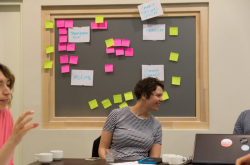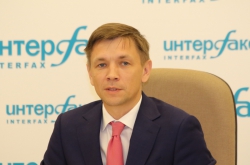Smart Space Hack InnoJam is a design-thinking session organized by ITMO’s Convergent Innovations Center as part of its collaboration with SAP Next-Gen Lab – an innovation and networking laboratory for students and young specialists. Its core function is to provide practical training to students, study SAP technologies and solve tasks relevant to the company’s clients. SAP Next-Gen Lab is created for the Generation Z – students and specialists who prioritize practice and career over raw theory.
“SAP Next-Gen is an initiative that helps universities introduce project-based learning into their classical educational processes. Our goal, as a technological brand and a company with plenty of clients among industrial and service companies, is to provide our clients a connection to students and let them supply the students with tasks that can be used for project work. This kind of activity helps students acquire practical skills while working on actual cases, learn to work in teams, and develop design thinking and emotional intelligence, i.e. acquire the kind of experience one usually gets from internships,” – comments Yury Kupriyanov, SAP University Alliances program manager at SAP CIS.
As the expert explains, SAP’s participation in such projects is due to their understanding of how necessary it is to talk to and interact with the younger generation, as the children of the 2000-s have different technology usage patterns. In order to successfully determine the right development vector in the future, the company needs to gather regular insight from members of the younger generation. Many other companies, too, believe in the efficiency of this approach. SAP Next-Gen Lab is modeled after Stanford D.School – a joint project by SAP and the Stanford University (USA) where students develop connected-car technologies for Audi and unmanned construction vehicles for Volvo. Among its clients are Renault, IKEA, NASA, Ford and many others. As Yuri Kupriyanov explains, the company aims to help introduce project work into the educational process, including as part of course papers and theses.

“For this InnoJam, we decided to support the United Nations’ sustainable development initiative, namely the Goal 9, which concerns infrastructure, industrialization, and innovation; smart products can’t exist separately from sustainable development. ITMO University’s Convergent Innovations Center initiated this design-thinking session with the goal of coming up with and outlining new, innovative approaches for the area of the University’s new campus. Our first objective was to develop a smart interior system for the educational spaces, with utility, comfort, and ease-of-use as key aspects. The second objective was the creation of a system for flexible space management and interaction with residents of coworking spaces; some of the key aspects here are ergonomics, transformation, and economy,” – explains Alexander Dorofeev, head of ITMO’s Convergent Innovations Center.
The event’s format was quite different from what one would expect from a regular hackathon. If hackathon participants tend to come in with prototypes completed by 40-60% and a fully formed team, a design-thinking session requires participants to form teams and develop ideas and prototypes right on the spot in the process of consulting with experts and clients.
Per Yuri Kupriyanov’s words, design thinking methodology is one of the instruments in innovations management and is an organized process of managing the creativity of groups of people; it can go for two days or six months. The main idea is that the participants develop an idea, create several prototypes and work with focus groups – all while being ready to rework their product from the ground up.
“On the one hand, this is an opportunity to get students involved in technological entrepreneurship with SAP, on the other – a way to commercialize their activity. The products made with our platform are published on a corporate app store, which lets students offer their ideas to our clients,” – he explains.
Before the design thinking session, the participants also attended a training course. Stepan Kukharsky, co-founder of SA Lab, spoke about adaptive decisions in architecture; Ivan Alyaskin of EPAM New York explained what smart spaces are; on the second day, Irina Shmeleva, associate professor at ITMO’s Institute of Design and Urban Studies, spoke about sustainable and “green” university campuses in the context of the UN’s sustainable development goals.
Projects
The winning team developed a solution for the issue of a lack of transforming smart interior objects. Bachelor’s and Master’s students from ITMO University, Saint-Petersburg State University of Architecture and Civil Engineering (SPSUACE) and St. Petersburg State University of Telecommunications (SPSUT) created a virtual mock-up of a modular system that can be used to create various interior objects (tables, chairs, storage systems, etc.) by combining different modules.
“Since everyone’s working space has to be individual, everyone should be able to take a creative approach to setting up a working space; our modular system is exactly what they need. We plan to use a fiberglass composite to create the framework for a physical version of the project. All the modules can also be equipped with various shells – for example, a soft one for a chair. If an element is damaged, it can easily be replaced with another,” – explained Yekaterina Sitnikova, member of the team and a third-year student at SPSUACE.

The team also suggested that the modules be equipped with sensors that would gather data on the users and their environment. The modular system is intended to be self-learning and able to automatically adjust itself for the users’ needs, memorizing the various configurations and controlling various environmental parameters such as air temperature. The whole system is controlled by a mobile app. Team members propose that such modular systems can be placed both indoors and outdoors.
A second team presented a project for an adaptable urban ecosystem that operates on several levels: city-wide, within an office and in a working space. To implement their idea, members of the team want to use smart bracelets that track users’ location, condition, mood, and movements within the environment. Users – students, teachers, researchers, workers, and entrepreneurs – all have an identity and a specific role in the system. Bracelets gather the user data, which is then processed and analyzed for behavior patterns, sent to the center for intellectual urban management, which works on transforming the urban environment. Transformation is done differently on each level: public transit on the city level, movable walls within offices and smart furniture at each particular working space.
Users, in turn, receive personalized advice on time management and places to see, as well as on how to avoid transportation issues. Smart bracelets help users plan optimal routes, make their working spaces ergonomic and suited to their needs, and relax by controlling the lighting, smell and audio effects in the room. All the bracelets are connected to an adaptive environment and can make decisions for the users, sometimes even without notifying them.





